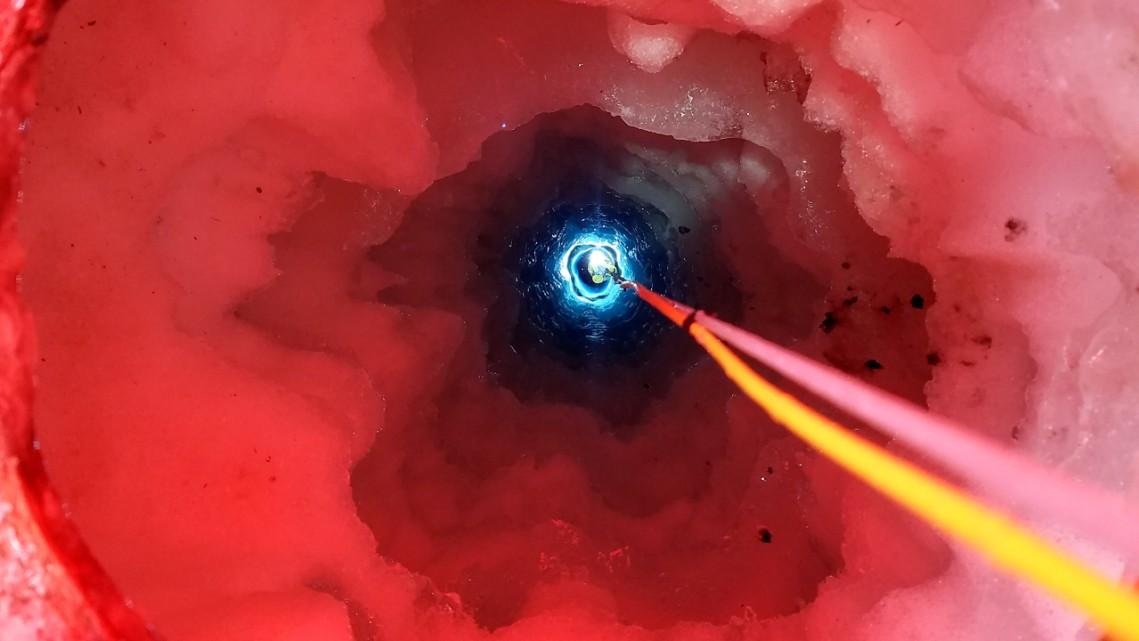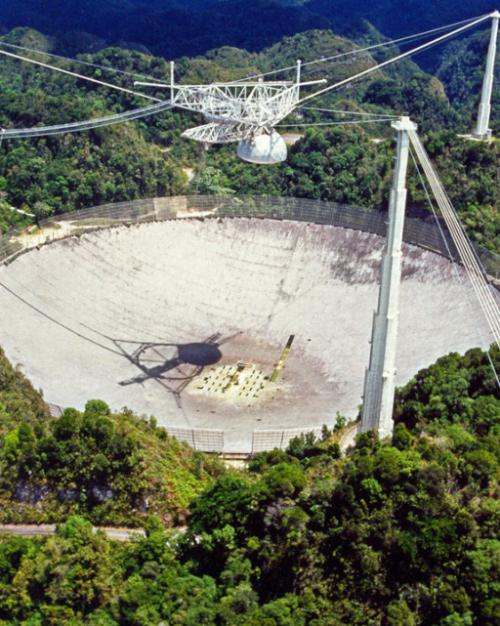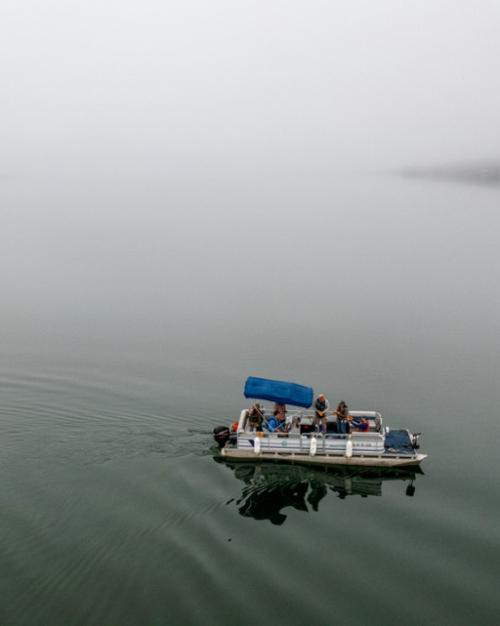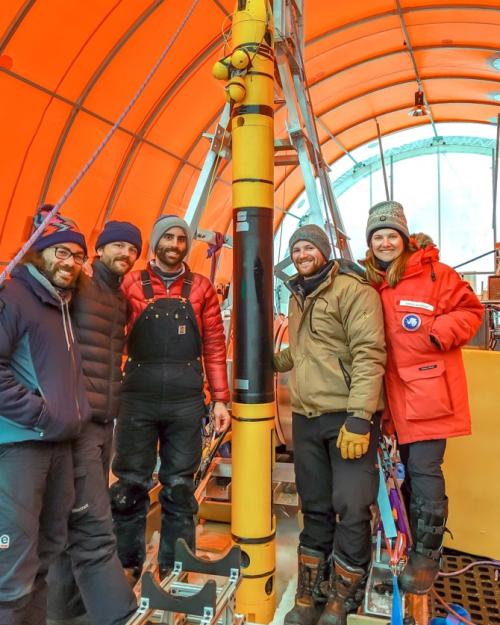High in a narrow, seawater-filled crevasse in the base of Antarctica’s largest ice shelf, cameras on the remotely operated Icefin underwater vehicle relayed a sudden change in scenery.
Walls of smooth, cloudy meteoric ice abruptly turned green and rougher in texture, transitioning to salty marine ice.
Nearly 1,900 feet above, near where the surface of the Ross Ice Shelf meets Kamb Ice Stream, a U.S.-New Zealand research team recognized the shift as evidence of “ice pumping” – a process never before directly observed in an ice shelf crevasse, important to its stability.
“We were looking at ice that had just melted less than 100 feet below, flowed up into the crevasse and then refrozen,” said Justin Lawrence, visiting scholar at the Cornell Center for Astrophysics and Planetary Science in the College of Arts and Sciences (A&S). “And then it just got weirder as we went higher up.”
The Icefin robot’s unprecedented look inside a crevasse, and observations revealing more than a century of geological processes beneath the ice shelf, are detailed in “Crevasse Refreezing and Signatures of Retreat Observed at Kamb Ice Stream Grounding Zone,” published March 2 in Nature Geoscience.
The paper reports results from a 2019 field campaign to Kamb Ice Stream supported by Antarctica New Zealand and other New Zealand research agencies, led by Christina Hulbe, professor at the University of Otago, and colleagues. Through support from NASA’s Astrobiology Program, a research team led by Britney Schmidt, associate professor of astronomy and earth and atmospheric sciences in A&S and Cornell Engineering, was able to join the expedition and deploy Icefin. Schmidt’s Planetary Habitability and Technology Lab has been developing Icefin for nearly a decade, beginning at the Georgia Institute of Technology.
Combined with recently published investigations of the fast-changing Thwaites Glacier – explored the same season by a second Icefin vehicle – the research is expected to improve models of sea-level rise by providing the first high-resolution views of ice, ocean and sea floor interactions at contrasting glacier systems on the West Antarctic Ice Sheet.
Thwaites, which is exposed to warm ocean currents, is one of the continent’s most unstable glaciers. Kamb Ice Stream, where the ocean is very cold, has been stagnant since the late 1800s. Kamb currently offsets some of the ice loss from western Antarctica, but if it reactivates could increase the region’s contribution to sea-level rise by 12%.
“Antarctica is a complex system and it’s important to understand both ends of the spectrum – systems already undergoing rapid change as well as those quieter systems where future change poses a risk,” Schmidt said. “Observing Kamb and Thwaites together helps us learn more.”
NASA funded Icefin’s development and the Kamb exploration to extend ocean exploration beyond Earth. Marine ice like that found in the crevasse may be an analog for conditions on Jupiter’s icy moon Europa, the target of NASA’s Europa Clipper orbital mission slated for launch in 2024. Later lander missions might one day search directly for microbial life in the ice.
Icefin carries a full complement of oceanographic instruments on a modular frame more than 12 feet long and less than 10 inches in diameter. It was lowered on a tether through a borehole the New Zealand team drilled through the ice shelf with hot water.
During three dives spanning more than three miles near the grounding zone where Kamb transitions to the floating Ross shelf, Icefin mapped five crevasses – ascending one – and the sea floor, while recording water conditions including temperature, pressure and salinity.
The team observed diverse ice features that provide valuable information about water mixing and melt rates. They included golf ball-like dimples, ripples, vertical runnels and the “weirder” formations near the top of the crevasse: globs of ice and finger-like protrusions resembling brinicles.
Ice pumping observed in the crevasse likely contributes to the relative stability of the Ross Ice Shelf – the world’s largest by area, the size of France – compared to Thwaites Glacier, the researchers said.
“It’s a way these big ice shelves can protect and heal themselves,” said Peter Washam (A&S), a polar oceanographer on the Icefin science team and the paper’s second author. “A lot of the melting that happens deep near the grounding line, that water then refreezes and accretes onto the bottom of the ice as marine ice.”
On the sea floor, Icefin mapped parallel sets of ridges that the researchers believe are impressions left behind by ice shelf crevasses – and a record of 150 years of activity since the Kamb stream stagnated. As its grounding line retreated, the ice shelf thinned, causing the crevasses to lift away. The ice’s slow movement over time shifted the crevasses seaward of the ridges.
“We can look at those sea floor features and directly connect them to what we saw on the ice base,” said Lawrence, the paper’s lead author, now a program manager and planetary scientist at Honeybee Robotics. “We can, in a way, rewind the process.”
In addition to Lawrence, Washam and Schmidt, Cornell co-authors of the research are Senior Research Engineers Matthew Meister, who led the Icefin engineering team, and Andrew Mullen; Research Engineer Daniel Dichek; and Program Manager Enrica Quartini. Schmidt’s team also includes Research Engineer Frances Bryson ’17, and at Georgia Tech, doctoral students Benjamin Hurwitz and Anthony Spears.
Also contributing were partners from New Zealand at the National Institute of Water and Atmospheric Research (NIWA); University of Auckland; University of Otago; and Victoria University of Wellington.
NASA supported the research through the Planetary Science and Technology from Analog Research program’s Project RISE UP (Ross Ice Shelf and Europa Underwater Probe), and the Future Investigators in NASA Earth and Space Science and Technology program. Additional support came from New Zealand’s Antarctic Science Platform, the U.S. Antarctic Program and Victoria University of Wellington’s Hot Water Drilling initiative.
Read the story in the Cornell Chronicle.





